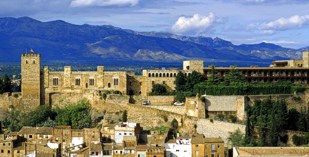
Tortosa, Catalonia, SpainSouth of Barcelona, Tortosa is located just off the east coast of Spain next to the River Ebro. A city of three cultures, it was originally founded by the Romans before the Moors took over for the next 400 years. Eventually in 1148, it was conquered by Count Ramon Berenguer IV of Barcelona. It has a special charm with its historical and artistic heritage, festivals and cuisine. The Romeu Portal is actually the entrance and exit gate to the Camion de Santiago (Saint James Way), a famous Christian pilgrimage route travelled for many centuries. The Camion route has been declared a Heritage of Humanity, and nowadays begins at the mouth of the Ebro River eventually linking with the French route. There are three main celebrations throughout the year. The Spring Festival is at the end of April, with processions that follow ancient traditions and an opportunity to try wonderful local dishes. The Feast of Nuestra Senora de la Cinta in September has a full schedule of events to suit all tastes. There is also a large Jazz Festival which combines all the different jazz styles in southern Catalonia. However, the Renaissance Festival, although it has only been going since 1996, has become quite a spectacle and extremely entertaining. With more than three thousand people in period costume and fifty performances a day, visitors are taken back to the Renaissance era. Within this walled city, there is a magnificent 10th century Castle, with four beautiful Catalan Gothic windows and a well called La Suda. The Castle has now become a four star luxury Parador Tortosa (Hotel Castillo de La Zuda), where guests can enjoy its beautiful interior of Christian and royal features with Arabic motifs on the walls. The Parador also has its own restaurant, bar, and swimming pool, as well as seasonal swimming pool outside. The Suda (or Sant Joan Castle) also dates back to the 10th century, and takes its name from the suda well, which plunges more than 45 metres deep before reaching the level of the river. This is also the site of the only outdoor Arabic cemetery in all of Catalonia. Other sites worth visiting are the 14th century Gothic Cathedral and Episcopal Palace. The Palace has an outstanding stairway with a courtyard and gallery, as well as a chapel that dates back to 1316. There is also the Royal College founded in 1564, the Archives Museum, and Jewish neighbourhood. The Exchange, built in the 14th century, was where the price of wheat was established for the entire Mediterranean basin. Another interesting tourist attraction is the outdoor sculpture museum, which exhibits the works of the Spanish artist Santiago. Beyond Tortosa, you can drive along the route of the Three Kings to the lovely village of Alcaniz. However, if you want a change from historical sites, and feel like a bit of adventure, there are numerous activities in the area. Everything from Micro lighting to horseback riding, boat trips along the river and jeep safaris. There is even a golf course nearby, and the Port Aventura Amusement Park, which provides great fun for the children. So if you choose Tortosa for your next holiday there will hopefully be something for every member of the family to enjoy. |